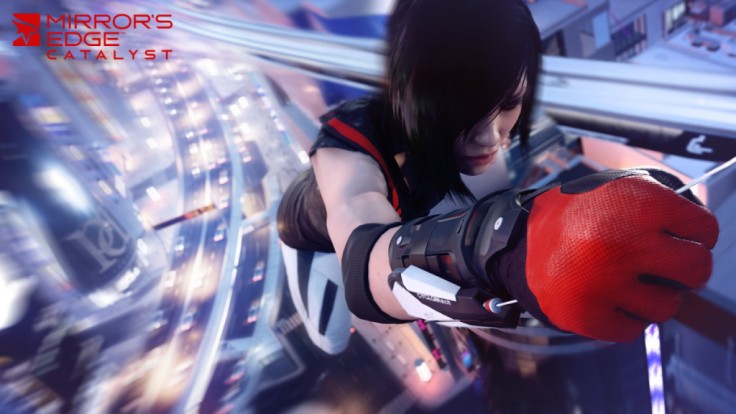What made the original Mirror’s Edge so enthralling when it released back in 2008 was its simplicity in both visual style and gameplay. The world was minimalistic in its design with a lot of white and blue that painted a futuristic city with popping red to highlight objects of interest that helped guide you through often challenging navigational puzzles in a game where movement and momentum were the focus. The prequel, Mirror’s Edge Catalyst, gives the city of Glass and our feisty and fast hero, Faith, a graphical overhaul with an open world map and plenty of side quests and collectables to keep you running around the different districts of the city for a long time after the end credits roll but unfortunately with Catalyst bigger does not mean better.
The storyline of the original was never ground-breaking but at least it was focused and knew what it was. It centred on a government conspiracy with Faith’s relationship with her sister as the catalyst for her motivation. Supported by a small cast of likeable characters it gave us just enough suspense to keep us running, and enough twists to keep us intrigued. Catalyst, however, feels like it has been stretched too far for its own good. There is a larger gang of characters this time around with their own stereotypical character traits. There is the obnoxious ally who you gradually befriend, the leader of another faction who holds different moral beliefs, the computer geek to provide exposition and information, and the mentor figure who you must prove yourself to. All of these characters could have been interesting to see Faith’s strong-headed personality go up against to create some interesting conflict but Catalyst is too busy rushing you from one objective and plot point to another leaving little time to properly develop these characters to make for any compelling relationships. Even the cute robot sidekick of our computer hacking friend feels like wasted potential by only having a few seconds of screen time and adding nothing to the game.

Perhaps the biggest issue with Catalyst’s relatively short-lived campaign is that it keeps you as an outsider to the events as they unfold. Throughout each mission, you are tasked with what are essentially fetch quests while the plot takes place around you rather than feeling like you are influencing the trajectory the narrative. For instance one mission involves a faction you ally with kidnap a key figure whilst you are tasked with running around a construction site to provide a distraction. As you follow a red trail directing you from point to point, the events of the kidnapping are being relayed to you via radio to remind you of what you could be doing. The missions do not have very much variety overall; the most common being to fetch objects or activate switches which becomes monotonous after the first few times. This is also the objective of every side quest: deliver this item here within a very strict time limit which demands you make the run in an almost perfect time. The constant restarts during the time it takes to learn each run becomes frustrating and is not helped by randomly spawning guard patrols or occasionally temperamental controls which make completing these missions feel more like a chore than playing a game.
When the components of Catalyst do come together, the momentous magic of the original returns as you effortlessly wall-run, vault, slide, and zip line through the city. Knocking-out a guard with the new traversal attacks feels extremely satisfying as do the occasional set pieces that see you narrowly escape from a collapsing structure or an intense chase sequence. There are even occasional missions that utilise clever platform puzzles whilst avoiding lasers which are really the only moments in Catalyst where your navigational skills are challenged.
Mirror’s Edge Catalyst feels like a game that was stretched beyond its capabilities. Its side quests and ability progression system feel like they were forced in to make it feel bigger than it is. Essentially that can summarise the game: an illusion of grandness. Cardboard characters, uninspired narrative and mission structures, and clunky combat controls are covered up by a glossy city which after some play time feels like you’re navigating through a labyrinth of pathways than using parkour to traverse a fully realised city. As a prequel, Catalyst does not care about its roots. Nothing is tied together, Faith’s origin story (when the narrative does decide to turn its attention to it) is muddled and nonsensical when joined up with the original particularly when it comes to her sister, Kate. Catalyst is like a huge stumble that ruins a flawless run. Running can be fun, but there is not enough momentum for Catalyst to make the jump so it falls flat on its face while you watch it slowly pick itself up and try again.
By Andrew Murray

Your review is somewhat dulled when you called Catalyst a prequel, which it isn’t. It’s a reboot.
LikeLike